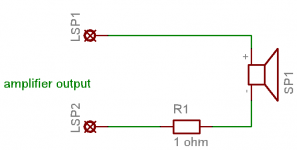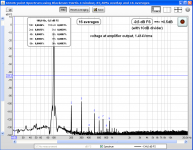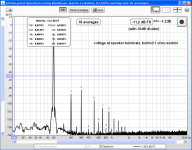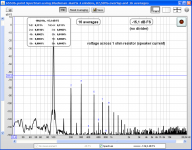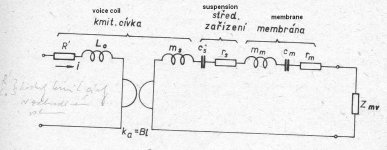Virtually all mid-fi, and some hi end manufacturers might use inexpensive loudspeaker drivers. I just know that the 'best' functioning loudspeakers are usually relatively costly, partly because of the 'hidden' compromises in the inexpensive ones. Geddes can be misinterpreted, but I bet like many, he does see electronics as pretty much the same as well as loudspeaker drivers.
I don't know yet how to build a really 'great' power amplifier, and I doubt that anybody else does. All to me have a 'signature' that I note over long listening experience. It is the same with preamps for the most part as well. I don't want an amp or preamp 'signature' in my designs and I will continue to find ways of eliminating it as much as possible. What I have tried to show here is how some passive parts, and active topologies can generate a 'signature' all their own. Yet even removing the obvious 'problems' there is more to do. Even my best amps are not 'perfect' sonically, except in a ABX test given by someone who doesn't believe in amplifier differences.
I don't know yet how to build a really 'great' power amplifier, and I doubt that anybody else does. All to me have a 'signature' that I note over long listening experience. It is the same with preamps for the most part as well. I don't want an amp or preamp 'signature' in my designs and I will continue to find ways of eliminating it as much as possible. What I have tried to show here is how some passive parts, and active topologies can generate a 'signature' all their own. Yet even removing the obvious 'problems' there is more to do. Even my best amps are not 'perfect' sonically, except in a ABX test given by someone who doesn't believe in amplifier differences.
I have one more set of measurements with the same method. Now it is at 100Hz and a speaker with 2 parallel 8" woofers. The difference in distortion of voltage at amplifier output compared to speaker current distortion is even bigger than in the test at the 1kHz midrange frequency.
One can see that woofers are creating high order distortion mostly at odd harmonics, up to 17th.
One can see that woofers are creating high order distortion mostly at odd harmonics, up to 17th.
Attachments
Last edited:
System Theme
This is more realistic.... but, you didnt add the 15 feet of speaker cable... which is crucial to the test and more real-world......that cable Rs and Ls and Cp is what caused the distortion build-up. The interfacing element. Your bulk R represnts amp Zo plus cable Rs and Ls. Note: It was a clue that the distortion with speaker cable was low at amp and high at driver... end of cable.
This may be a partial explanation as to why people heard variations with different amps/cable or same amp but different cable/speaker combo's??
One needs to measure as a system.. with all elements and not in isolation to each component..... we also listen this way.
The SIM masters have explored this behaviour and come up now with which OPS topologies minimize the effect. Once a problem is found and understood, a solution is usually found.
PAmps... like preAmps and Opamps have biggest problem with the OPS in many ways. So, that needs more attention focused on it. IMO. Things just keep getting better. Now if we could just get better recording practices and sound-field recordings et al.
Things just keep getting better. Now if we could just get better recording practices and sound-field recordings et al.
THx-RNMarsh
I have one more set of measurements with the same method. Now it is at 100Hz and a speaker with 2 parallel 8" woofers. The difference in distortion of voltage at amplifier output compared to speaker current distortion is even bigger than in the test at the 1kHz midrange frequency.
One can see that woofers are creating high order distortion mostly at odd harmonics, up to 17th.
This is more realistic.... but, you didnt add the 15 feet of speaker cable... which is crucial to the test and more real-world......that cable Rs and Ls and Cp is what caused the distortion build-up. The interfacing element. Your bulk R represnts amp Zo plus cable Rs and Ls. Note: It was a clue that the distortion with speaker cable was low at amp and high at driver... end of cable.
This may be a partial explanation as to why people heard variations with different amps/cable or same amp but different cable/speaker combo's??
One needs to measure as a system.. with all elements and not in isolation to each component..... we also listen this way.
The SIM masters have explored this behaviour and come up now with which OPS topologies minimize the effect. Once a problem is found and understood, a solution is usually found.
PAmps... like preAmps and Opamps have biggest problem with the OPS in many ways. So, that needs more attention focused on it. IMO.
THx-RNMarsh
Last edited:
Note: It was a clue that the distortion with speaker cable was low at amp and high at driver... end of cable.
This is not necessarily so, there is potential to get very confused here. You can't measure only voltage at one end and current at the other. You could just as well have the same non-linear current with an ideal voltage amplifier connected directly to the speaker the cable doing in effect nothing.
Until the easily measured frequency response differences are eliminated as a problem, I would look elsewhere.
Last edited:
This is more realistic.... but, you didnt add the 15 feet of speaker cable... which is crucial to the test and more real-world.....
I forgot to mention that "speaker voltage" means with 2x6 feet of the speaker cable. I agree with Scott, this is not important, re distortion.
Both measurements shown (100Hz and 1kHz) are "realistic" as they were measured with a real, 3- way speaker.
Just to show, for those who are not aware, why current defines speaker distortion, pls see the attachment.
Attachments
Last edited:
All of this led me to some interesting (but probably heretic) thoughts: the back emf from the driver is distorted and this is reflected in the current, since the said driver is loaded by the (hopefully) negligible output impedance of the amp.
The force driving the voice coil is an image of the current: the acoustic output is therefore also distorted.
Now, let's imagine the output impedance of the amplifier is infinite: the modulation of the current by the back emf disappears, and as a consequence the distortion....
Too good to be true? Probably: where would the back emf distortion come from in the first place? It is a chicken and egg problem.
I am not a fan of current drive anyway, but the subject might deserve deeper thought after all
The force driving the voice coil is an image of the current: the acoustic output is therefore also distorted.
Now, let's imagine the output impedance of the amplifier is infinite: the modulation of the current by the back emf disappears, and as a consequence the distortion....
Too good to be true? Probably: where would the back emf distortion come from in the first place? It is a chicken and egg problem.
I am not a fan of current drive anyway, but the subject might deserve deeper thought after all
That "signature" is the remaining audible distortion, which obviously the classic THD measurements, that say Pavel does, do not reveal. Hence, chasing ever lower and lower numbers here is no guarantee that the amp becomes "transparent"; but it will certainly improve its chances of doing so - IME the real gains are when the little details are carefully considered, and the interesting result I got is that subjectively superior sound occurs even for 'mediocre' equipment, when these same small details are dealt with, for them.I don't know yet how to build a really 'great' power amplifier, and I doubt that anybody else does. All to me have a 'signature' that I note over long listening experience. It is the same with preamps for the most part as well. I don't want an amp or preamp 'signature' in my designs and I will continue to find ways of eliminating it as much as possible. What I have tried to show here is how some passive parts, and active topologies can generate a 'signature' all their own. Yet even removing the obvious 'problems' there is more to do. Even my best amps are not 'perfect' sonically, except in a ABX test given by someone who doesn't believe in amplifier differences.
All of this led me to some interesting (but probably heretic) thoughts: the back emf from the driver is distorted and this is reflected in the current, since the said driver is loaded by the (hopefully) negligible output impedance of the amp.
No, this is a nonsense.
The amplifier output voltage reflects "back EMF" as well. Speaker current is distorted because almost all elements of the speaker lumped diagram are non-linear. Voice coil Le is nonlinear, stiffness is nonlinear, cone has break-ups, B is nonlinear with voice coil position, almost everything you point at is nonlinear. Perfectly linear voltage divided by nonlinear impedance will produce nothing but nonlinear current, there is no option. The only cure would be a current drive with frequency response equalization. The last is not easy near to driver resonance.
Last edited:
I can see some misunderstanding here, and I am afraid it is a fruit of popular audio magazines and marketing talk.
You may have an amplifier with zero output distortion, perfect voltage drive of the speaker, and you will get distorted speaker current through its nonlinear impedance.
I = V / Z(nonlinear)
Even if V is a pure tone with no distortion, I will be distorted. Simple. No other option.
Time to finish with this debate
You may have an amplifier with zero output distortion, perfect voltage drive of the speaker, and you will get distorted speaker current through its nonlinear impedance.
I = V / Z(nonlinear)
Even if V is a pure tone with no distortion, I will be distorted. Simple. No other option.
Time to finish with this debate
Yes. IME so many problem start to intrude when serious power is required, meaning serious current comes into the picture. Very few amplifiers are able to deliver higher levels of current to the speakers in a way that doesn't cause problems somewhere in the reproduction chain - this is why the majority of systems can't be run at realistic sound levels without making it very clear that some part of the system is now below par.I think it is easier to make a transparent pre amplifier than a power amp. The loud speaker amp interface is a bit more problematic
Last edited:
No VISIBLE distortion? Is that all it takes?
Well yes, sort of. Want to see nonlinear distortion diminishing with decreasing input level, right?
Geddes was measuring with noise components averaged out. Way down.
Couldn't see it, couldn't hear it. What's the downside?
I said, sort of. Like you, he doesn't want signals coming to his speakers with higher order distortion components cuz our hearing won't mask them very well.
In your next post:
Nah. He's a value guy. Uses B&C drivers - good price/performance.he has simplified loudspeakers down to the fundamental equation and geometry, and forgot all the compromises and tradeoffs in different loudspeaker drivers.
He's saying pro speakers and drivers are more alike than different used in a DOMESTIC application, because they are not pushed into nasty non linear regions and just coast along.
Anyway, since he thinks speakers should have no particular sound - should be neutral - he's going to compensate them to his ideal....
So pro drivers are commodities for him, just like transistors are for you.
I gotta say I have a soft spot for Geddes because he sorted out an awful lot of the linear, acoustic glitches in horn/waveguides and speakers that subjectively sound like non-linear distortion at high SPLs.
Which means, BTW, gear like yours can sound its best!
I hoped it was clear  . Speaker is defined by current (B*L*i). Undistorted amplifier output voltage does not help. You need to feed the speaker with undistorted current. When driven with undistorted voltage, speaker will distort the current through its nonlinear impedance. Is it so much to ask knowledge of Ohm law? If yes, the debate is useless.
. Speaker is defined by current (B*L*i). Undistorted amplifier output voltage does not help. You need to feed the speaker with undistorted current. When driven with undistorted voltage, speaker will distort the current through its nonlinear impedance. Is it so much to ask knowledge of Ohm law? If yes, the debate is useless.
All of this led me to some interesting (but probably heretic) thoughts: the back emf from the driver is distorted and this is reflected in the current, since the said driver is loaded by the (hopefully) negligible output impedance of the amp.
The force driving the voice coil is an image of the current: the acoustic output is therefore also distorted.
Now, let's imagine the output impedance of the amplifier is infinite: the modulation of the current by the back emf disappears, and as a consequence the distortion....
Too good to be true? Probably: where would the back emf distortion come from in the first place? It is a chicken and egg problem.
I am not a fan of current drive anyway, but the subject might deserve deeper thought after all
Makes sense to me. It's probably not universally true, but there are measurements that show a high source impedance can be a good thing for a speaker if the EQ is taken care of:
Current-Drive - The Natural Way of Loudspeaker Operation
Hmmmmm. When you put 1 Ohm in series the measured distortion increased. Non-linear speaker Z.
As far as I am concerned.... this is similar to a cable placed in series... though less complex.
It isnt theory -- it is measurement that I refer to. Low distortion at the amp terminals and higher at the speaker terminals with zip cord in between terminals.
Do I understand correctly that regardless, there is no net increase in distortion from the speaker output and no effect on any amplifier either?
BUT, in circuit SIM of amps, like I said, some back-emf does get backwards thru a non-perfect amplifier OPS. When that gets improved, and sim showed the way, then things get a lot better. i wouldnt be surprised if it sounded better as well. Just need for the info to get into commercial products in a decade or two. Hopefully, sooner.
THx-RNMarsh
As far as I am concerned.... this is similar to a cable placed in series... though less complex.
It isnt theory -- it is measurement that I refer to. Low distortion at the amp terminals and higher at the speaker terminals with zip cord in between terminals.
Do I understand correctly that regardless, there is no net increase in distortion from the speaker output and no effect on any amplifier either?
BUT, in circuit SIM of amps, like I said, some back-emf does get backwards thru a non-perfect amplifier OPS. When that gets improved, and sim showed the way, then things get a lot better. i wouldnt be surprised if it sounded better as well. Just need for the info to get into commercial products in a decade or two. Hopefully, sooner.
THx-RNMarsh
Last edited:
- Status
- Not open for further replies.
- Home
- Member Areas
- The Lounge
- John Curl's Blowtorch preamplifier part II
